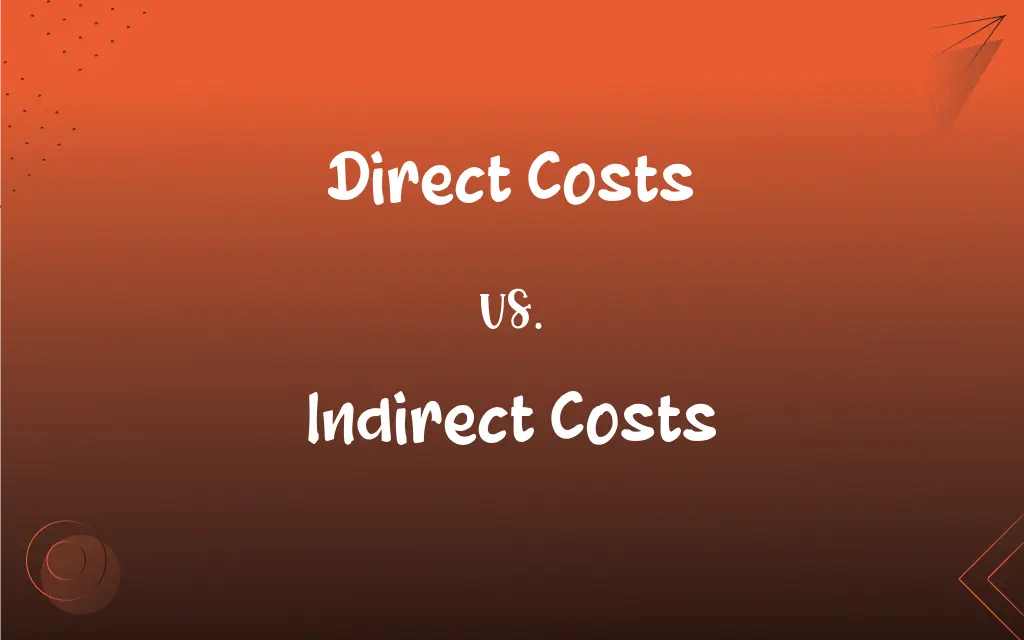Direct Costs vs. Indirect Costs: What's the Difference?
Edited by Harlon Moss || By Janet White || Published on November 13, 2023
Direct Costs: Expenses directly tied to a product/service. Indirect Costs: Expenses not directly linked to a product/service but necessary for operations.

Key Differences
Direct Costs are specifically associated with the production of goods or services, such as raw materials and labor. In contrast, Indirect Costs are general business expenses, like utilities and rent, that support the overall operations but are not tied to a specific product.
While Direct Costs can be easily traced to a product, making them quantifiable and attributable, Indirect Costs are allocated over multiple projects or products, making them less tangible and often harder to assign precisely.
Direct Costs often fluctuate with the level of production, as more materials or labor might be needed for increased output. On the other hand, Indirect Costs tend to remain stable, irrespective of production levels, as they are often fixed costs like insurance or administrative salaries.
In pricing strategies, Direct Costs are pivotal in determining the cost of goods sold and setting product prices. In contrast, Indirect Costs are considered when calculating the overall profitability and operational expenses of a company.
For budgeting and financial analysis, Direct Costs provide insight into variable expenses directly affecting production, whereas Indirect Costs help in understanding the underlying overheads and operational efficiency of the business.
ADVERTISEMENT
Comparison Chart
Association
Directly linked to production/service
Linked to overall business operations
Variability
Variable with production levels
Often fixed, regardless of production
Traceability
Easily traceable to a specific product
Difficult to trace to a single product
Pricing Impact
Affects cost of goods sold and product prices
Affects overall profitability
Budgeting Role
Key in variable expenses management
Key in managing overheads and efficiency
ADVERTISEMENT
Direct Costs and Indirect Costs Definitions
Direct Costs
Specific expenses for manufacturing a product.
The direct costs for the gadget were materials and assembly labor.
Indirect Costs
Expenses not directly tied to a specific product.
The office rent was considered an indirect cost.
Direct Costs
Expenses directly attributable to a product.
The direct costs for the chair included wood and labor.
Indirect Costs
Costs spread across multiple products or services.
Administrative salaries were categorized as indirect costs.
Direct Costs
Costs that vary with production level.
As production increased, so did the direct costs.
Indirect Costs
Expenses not easily traced to a single product.
The company’s advertising budget was an indirect cost.
Direct Costs
Costs directly tied to a service provided.
The direct costs of the consulting service included the consultant's fees.
Indirect Costs
Overhead costs necessary for overall functioning.
Insurance premiums were a significant indirect cost.
Direct Costs
Expenditures traceable to a cost object.
The direct costs for the project were the specialized parts.
Indirect Costs
General overhead expenses for business operations.
Utilities were part of the company's indirect costs.
FAQs
Can Direct Costs vary?
Yes, they often vary with the level of production.
Are Indirect Costs fixed or variable?
They are often fixed and do not vary much with production levels.
What are Direct Costs?
Expenses specifically linked to the production of a product or service.
Do Indirect Costs impact profitability?
Yes, they affect overall company profitability and operational expenses.
Can Direct Costs be allocated?
They are usually not allocated, as they're directly traceable to a product.
Is rent a Direct or Indirect Cost?
Typically, rent is considered an Indirect Cost.
What are Indirect Costs?
General business expenses not directly attributable to a specific product.
Are salaries Direct Costs?
Only if directly tied to production; otherwise, they're Indirect Costs.
How do Direct Costs affect pricing?
They directly influence the cost of goods sold and product pricing.
How are Indirect Costs allocated?
They are allocated over multiple projects or products based on certain criteria.
Can Indirect Costs be reduced?
Yes, by improving operational efficiency and reducing overheads.
Do service industries have Direct Costs?
Yes, like labor or materials specifically used for a service.
Are Indirect Costs important for budgeting?
Absolutely, as they contribute to understanding overall expenses.
Is packaging a Direct Cost?
Yes, if directly related to the product, it's considered a Direct Cost.
Is depreciation a Direct or Indirect Cost?
Typically, it's categorized as an Indirect Cost.
How do Direct Costs impact financial analysis?
They provide insight into variable production expenses.
Are Direct Costs the same for all products?
No, they can differ based on the product's specific production needs.
Are utility bills Direct or Indirect Costs?
Usually, they are classified as Indirect Costs.
Can Direct Costs help in setting product prices?
Yes, they play a crucial role in determining product prices.
Why are Indirect Costs hard to trace?
Because they're not directly linked to a single product or service.
About Author
Written by
Janet WhiteJanet White has been an esteemed writer and blogger for Difference Wiki. Holding a Master's degree in Science and Medical Journalism from the prestigious Boston University, she has consistently demonstrated her expertise and passion for her field. When she's not immersed in her work, Janet relishes her time exercising, delving into a good book, and cherishing moments with friends and family.
Edited by
Harlon MossHarlon is a seasoned quality moderator and accomplished content writer for Difference Wiki. An alumnus of the prestigious University of California, he earned his degree in Computer Science. Leveraging his academic background, Harlon brings a meticulous and informed perspective to his work, ensuring content accuracy and excellence.






































































